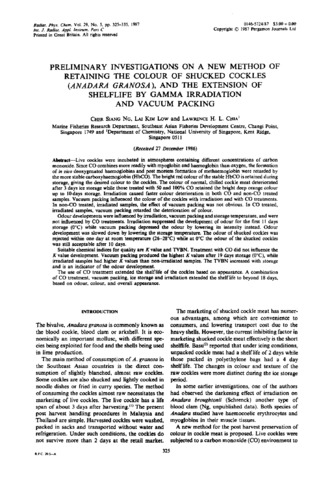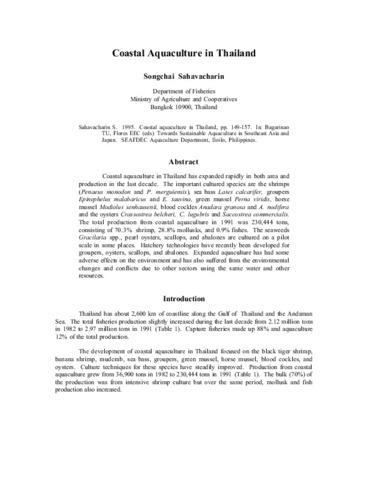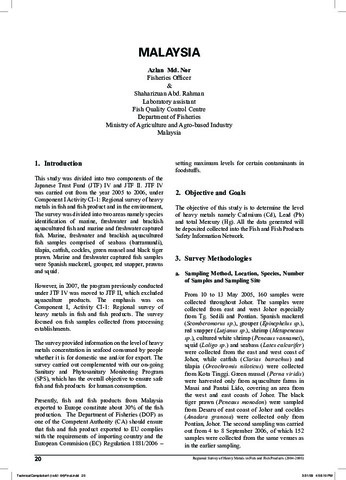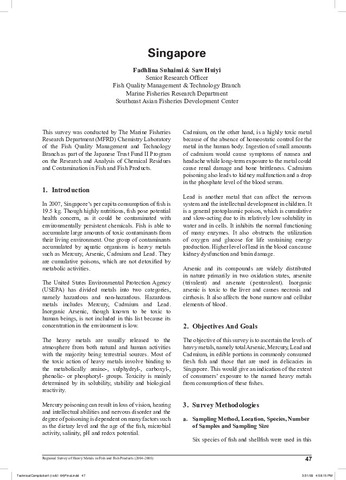Preliminary investigations on a new method of retaining the colour of shucked cockles (Anadara Granosa), and the extension of shelflife by gamma irradiation and vacuum packing

View/
Request this document
Date
1987Page views
505Metadata
Show full item recordCited times in Scopus
Share
Abstract
Live cockles were incubated in atmospheres containing different concentrations of carbon monoxide. Since CO combines more readily with myoglobin and haemoglobin than oxygen, the formation of in vivo deoxygenated haemoglobins and post mortem formation of methaemoglobin were retarded by the more stable carboxyhaemoglobin (HbCO). The bright red colour of the stable HbCO is retained during storage, giving the desired colour to the cockles. The colour of normal, chilled cockle meat deteriorated after 3 days ice storage while those treated with 50 and 100% CO retained the bright deep orange colour up to 10 days storage. Irradiation caused faster colour deterioration in both CO and non-CO treated samples. Vacuum packing influenced the colour of the cockles with irradiation and with CO treatments. In non-CO treated, irradiated samples, the effect of vacuum packing was not obvious. In CO treated, irradiated samples, vacuum packing retarded the deterioration of colour.
Odour developments were influenced by irradiation, vacuum packing and storage temperature, and were not influenced by CO treatments. Irradiation suppressed the development of odour for the first 11 days storage (0°C) while vacuum packing depressed the odour by lowering its intensity instead. Odour development was slowed down by lowering the storage temperature. The odour of shucked cockles was rejected within one day at room temperature (26–28°C) while at 0°C the odour of the shucked cockles was still acceptable after 10 days.
Suitable chemical indices for quality are K value and TVBN. Treatment with CO did not influence the K value development. Vacuum packing produced the highest K values after 19 days storage (0°C), while irradiated samples had higher K values than non-irradiated samples. The TVBN increased with storage and is an indicator of the odour development.
The use of CO treatment extended the shelflife of the cockles based on appearance. A combination of CO treatment, vacuum packing, ice storage and irradiation extended the shelflife to beyond 18 days, based on odour, colour, and overall appearance.
Suggested Citation
Ng, C. S., Low, L. K., & Chia, L. H. L. (1987). Preliminary investigations on a new method of retaining the colour of shucked cockles (Anadara Granosa), and the extension of shelflife by gamma irradiation and vacuum packing. International Journal of Radiation Applications and Instrumentation. Part C. Radiation Physics and Chemistry , 29(5), 325-335. https://doi.org/10.1016/1359-0197(87)90002-6
Subject
Taxonomic term
Collections
Related items
Showing items related by title, author, creator and subject.
-
Coastal aquaculture in Thailand
Sahavacharin, Songchai (Aquaculture Department, Southeast Asian Fisheries Development Center, 1995)Coastal aquaculture in Thailand has expanded rapidly in both area and production in the last decade. The important cultured species are the shrimps (Penaeus monodon and P. merguiensis), sea bass Lates calcarifer, groupers ... -
Regional survey of heavy metals in fish and fish products: Malaysia
Nor, Azlan Md. (Marine Fisheries Research Department, Southeast Asian Fisheries Development Center, 2008)The paper presents the results of the survey that was conducted to determine the level of heavy metals namely cadmium, lead, and total mercury among the marine, freshwater and brackishwater (aquacultured) fishes in Malaysia. ... -
Regional survey of heavy metals in fish and fish products: Singapore
Suhaimi, Fadhlina; Huiyi, Saw (Marine Fisheries Research Department, Southeast Asian Fisheries Development Center, 2008)The paper presents the results of the survey that aimed to ascertain the levels of heavy metals, namely total arsenic, mercury, lead and cadmium in edible portions of commonly consumed fishes and those that are used in ...





